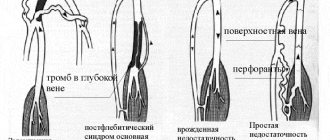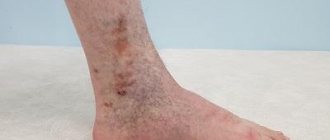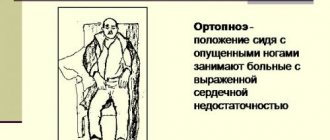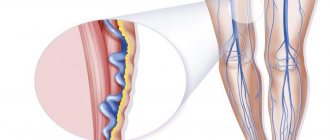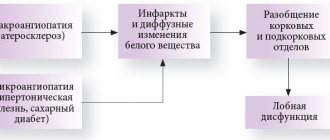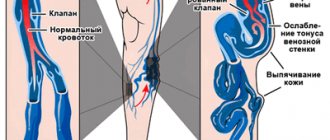Surgeon
Bohyan
Tigran Surenovich
Experience 36 years
Surgeon of the highest category, Doctor of Medical Sciences, member of the International Association of Surgeons, Gastroenterologists and Oncologists
Make an appointment
Lymphostasis of the lower extremities is lymphatic edema, which is caused by the fact that the outflow of lymph is disrupted and it stagnates in the tissues. It is visually clear that the leg that is susceptible to this disease is enlarged and swollen. But let's talk about the symptoms in more detail.
Varicose veins as one of the causes of chronic venous insufficiency
By the term “chronic venous insufficiency”, modern medical science means a symptom complex associated with impaired venous outflow. Chronic venous insufficiency (CVI) is caused by a number of diseases that lead to disruption of the normal functioning of the venous system, most often of the lower extremities.
The clinical picture of chronic venous insufficiency is very diverse and depends on the stage of the disease.
Prevention of vein diseases: You can do it yourself
“It is better to walk or lie down than to sit or stand.” This is the rule of thumb of the German Venous Society (Deutschen Venen-Liga e.V.) Movement helps keep the veins healthy and elastic. Alternating contractions and relaxations of the leg muscles maintain venous blood flow, and special exercises help keep the veins healthy. .
Hot/cold showers also improve the condition of your feet.
Patients with venous diseases should, if possible, exclude
or at least minimize
the “risk factors they may influence” described above.
The treatment process is positively influenced by: proper nutrition, maintaining normal body weight, regular physical activity (for example, walking, swimming, cycling). It is recommended to limit alcohol consumption.
Replace high heels more often with shoes with low heels or almost flat soles: in high heels, the foot exhibits only very limited muscle activity, so that muscle pressure on the venous system is reduced. Wearing flat shoes activates the calf pump.
Chronic venous insufficiency. Symptoms and signs
Almost every resident of Moscow and the Moscow region has encountered the initial signs of chronic venous insufficiency (CVI). The modern rhythm of life and an unbalanced diet have far from the best effect on the condition of the veins of the lower extremities. The leading initial manifestations of chronic venous insufficiency are as follows:
- Swelling of the feet and legs towards the end of the day, which decreases after a night's rest or when walking
- Unpleasant feeling of heaviness in the calf area that occurs when standing or sitting for a long time
Later, the patient begins to feel a feeling of heat in the legs, bursting pain in the calves and night cramps in the calf muscles. External changes boil down to the formation of small blue-red vascular “stars” in the thighs and legs, the appearance of dark blue intradermal and intricately convoluted varicose veins. The latter look like dark blue conglomerates and resemble bunches of grapes in the later stages. As chronic venous insufficiency (CVI) progresses, the skin of the lower leg becomes dry and sensitive to various types of injuries and damage.
Advanced forms of chronic venous insufficiency
Subsequently, small islands of a characteristic dark brown color form on the skin, which gradually merge into a single conglomerate. In its central part there appears an area that looks like a leak of stearin. The next stage of chronic venous insufficiency is a trophic ulcer. Despite the availability of modern medical care, many residents of Moscow and the Moscow region live with venous trophic ulcers for many years. It is not always possible for a surgeon in a state clinic, even in Moscow, to help with the treatment of this unpleasant illness. Therefore, it is necessary to contact specialized specialists, phlebologists who possess innovative technologies for the treatment of varicose veins and chronic venous insufficiency (CVI). In specialized city phlebology centers you can count on really good help.
Diagnosis and treatment of CVI
To avoid serious consequences and cope with the disease in its first stages, you should consult a doctor at the first manifestations of the disease. In Moscow, qualified assistance can be obtained at the First Phlebological Center.
Diagnostics involves a visual examination of the limbs, as well as an ultrasound examination, which gives a complete picture of the condition of the blood vessels. Based on the diagnosis, treatment will be prescribed. It is usually combined and includes:
- compression using special bandages or medical knitwear;
- taking medications that help restore the elasticity of vascular walls;
- the use of ointments and gels that reduce swelling and pain.
Depending on individual characteristics, the doctor may also prescribe diet, swimming, exercise, massage, etc.
Chronic venous insufficiency. Causes
The leading and most common cause of chronic venous insufficiency (CVI) is varicose veins. This pathology occurs as a result of hereditary or acquired venous valve insufficiency, decreased tone of the venous wall and high venous pressure due to blood reflux.
Causes of chronic venous insufficiency
The prerequisites are sudden physical overexertion, prolonged static load on the lower limbs, childbirth and pregnancy.
Prevention of vein diseases
Prevention of vein diseases: You can do it yourself:
- Sports and exercise: “It is better to walk or lie down than to sit or stand.” This is the rule of thumb of the German Venous Society (Deutschen Venen-Liga e.V.) Movement helps keep the veins healthy and elastic. Alternating contractions and relaxations of the leg muscles maintain venous blood flow, and special exercises help keep the veins healthy.
- Diet: A healthy, balanced diet is essential. It is recommended to limit alcohol consumption.
- Weight control: Maintain a normal body weight.
- Clothing and shoes: Wear loose, comfortable clothing. Swap high-heeled shoes for flat shoes: Feet move better in flat shoes, which activate the musculovenous pump. On the contrary, in high heels the contraction of the calf muscles is limited, so that the pressure on the veins is reduced.
- Showering: Hot/cold showers also improve the condition of your feet.
Chronic venous insufficiency and varicose veins
As the leading cause of chronic venous insufficiency (CVI), varicose veins deserve special attention and consideration. From the standpoint of modern European phlebologists, varicose veins are classified according to the type of blood reflux:
- Vertical reset
- Horizontal reset
In the first case, damage to the valve occurs in the groin area or under the knee, resulting in a downward discharge. The main trunk of the saphenous vein gradually begins to expand due to the constant discharge of blood from veins located deeper. The venous wall is stretched, which leads to damage to the next valve. The described condition is diagnosed as a stem type of varicose veins.
Varicose veins and chronic venous insufficiency
Horizontal discharge is characterized by disruption of the functioning of perforating and communicating veins and their tributaries. European medicine notes the great importance of horizontal discharge for the development of symptoms of chronic venous insufficiency (CVI). However, horizontal reflux develops in most cases later than vertical reflux and indicates the neglect of the pathological process.
Why is venous congestion in the legs dangerous?
1. The risk of developing superficial thrombophlebitis Venous congestion in the legs is accompanied by an increase in blood viscosity. Increased blood clotting and a decrease in the speed of venous blood flow provoke the formation of blood clots (thrombi) on the inner surface of the vascular walls of the veins. Having come off the vein wall and entering the venous bed, the thrombus can clog a superficial vein of small diameter and provoke superficial thrombophlebitis. Blockage of a vein leads to disruption of the blood supply to the skin area. Over time, a difficult-to-treat trophic ulcer forms on the affected area of the skin.
2. Risk of developing varicose veins Stagnation of blood in the legs increases the pressure inside the veins. Under the influence of excess pressure, the veins begin to stretch and appear under the skin, forming a network of dilated veins in the legs. Increased pressure inside the veins “squeezes” the liquid part of the blood through the vascular walls of the veins into the muscles and subcutaneous tissue of the legs. Because of this, severe varicose edema occurs.
The Russian company produces compression garments intended for the treatment of venous stagnation , varicose veins, lymphatic and post-traumatic edema. You can learn more about how Intex elastic stockings and tights help with varicose veins in the article “Treatment of Venous Congestion.”
Chronic venous insufficiency. Complications
Disturbances in venous outflow lead to both the extreme degree of chronic venous insufficiency (CVI) - venous trophic ulcers, and thrombosis associated with slow blood flow and chronic inflammation of the venous wall.
Varicose veins and venous insufficiency in the form of ulcers
Medical complications of chronic venous insufficiency not only sharply worsen the quality of life, but also pose a direct threat to it.
Reasons for appearance
The most important factor in the occurrence of vein diseases is hereditary predisposition. It is this that determines the characteristics of the condition of tissues and blood vessels.
Another reason is associated with diseases and conditions caused by problems with venous circulation: thrombosis, trauma, varicose veins.
The third group of factors includes lifestyle: passive lifestyle, excess weight, excessive loads that involve lifting heavy objects. No less significant factors are the age category and hormonal background of the patient.
Doctors consider the following people at risk:
- athletes;
- women (pregnancy and changes in hormonal levels can affect venous circulation);
- people who have a family history of venous disease.
Chronic venous insufficiency. Treatment
The treatment of this disease is based on two basic principles that complement each other, namely: eliminating the symptoms of chronic venous insufficiency and treating the disease that caused it, varicose veins. To eliminate varicose veins, the best solution would be modern methods of endovasal thermoobliteration (laser and radiofrequency).
Treatment of CVI using endovenous thermal methods
Compression therapy and modern venotonics have a good effect against the symptoms of chronic venous insufficiency (CVI). It is an integrated approach to the problem of chronic venous insufficiency that will be its optimal solution.
Residents of Moscow and the Moscow region have a good choice of both phlebology clinics and phlebologists themselves. Artyom Yurievich Semenov, vascular surgeon, head and leading specialist of the Moscow City Phlebology Center, is one of the best experts in the innovative treatment of chronic venous insufficiency (CVI) and varicose veins.
If you contact the city phlebology center, you are guaranteed to be diagnosed according to the best European standards. After modern diagnostics, innovative treatment will be prescribed and carried out as soon as possible.

